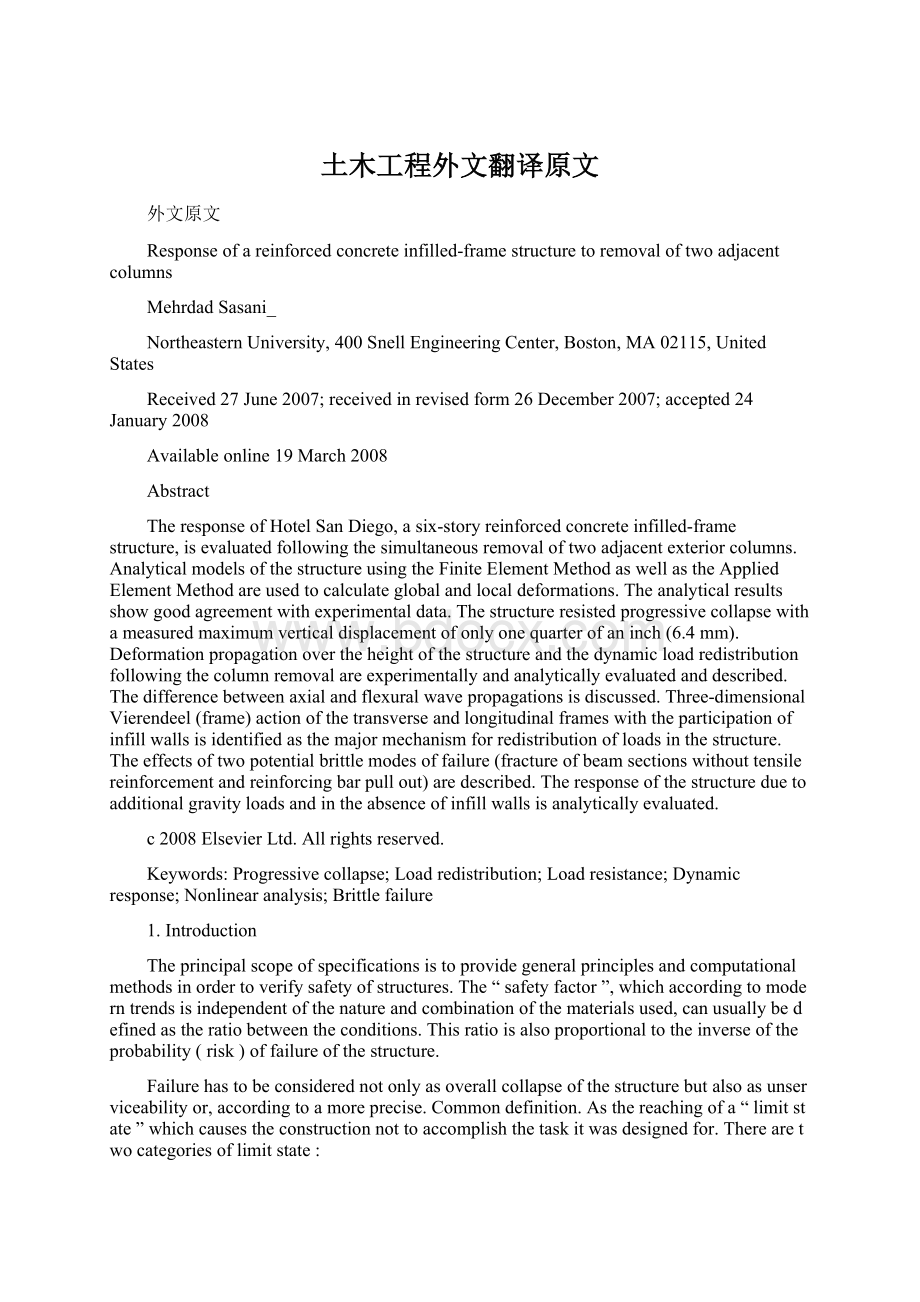土木工程外文翻译原文.docx
《土木工程外文翻译原文.docx》由会员分享,可在线阅读,更多相关《土木工程外文翻译原文.docx(12页珍藏版)》请在冰豆网上搜索。

土木工程外文翻译原文
外文原文
Responseofareinforcedconcreteinfilled-framestructuretoremovaloftwoadjacentcolumns
MehrdadSasani_
NortheasternUniversity,400SnellEngineeringCenter,Boston,MA02115,UnitedStates
Received27June2007;receivedinrevisedform26December2007;accepted24January2008
Availableonline19March2008
Abstract
TheresponseofHotelSanDiego,asix-storyreinforcedconcreteinfilled-framestructure,isevaluatedfollowingthesimultaneousremovaloftwoadjacentexteriorcolumns.AnalyticalmodelsofthestructureusingtheFiniteElementMethodaswellastheAppliedElementMethodareusedtocalculateglobalandlocaldeformations.Theanalyticalresultsshowgoodagreementwithexperimentaldata.Thestructureresistedprogressivecollapsewithameasuredmaximumverticaldisplacementofonlyonequarterofaninch(6.4mm).Deformationpropagationovertheheightofthestructureandthedynamicloadredistributionfollowingthecolumnremovalareexperimentallyandanalyticallyevaluatedanddescribed.Thedifferencebetweenaxialandflexuralwavepropagationsisdiscussed.Three-dimensionalVierendeel(frame)actionofthetransverseandlongitudinalframeswiththeparticipationofinfillwallsisidentifiedasthemajormechanismforredistributionofloadsinthestructure.Theeffectsoftwopotentialbrittlemodesoffailure(fractureofbeamsectionswithouttensilereinforcementandreinforcingbarpullout)aredescribed.Theresponseofthestructureduetoadditionalgravityloadsandintheabsenceofinfillwallsisanalyticallyevaluated.
c2008ElsevierLtd.Allrightsreserved.
Keywords:
Progressivecollapse;Loadredistribution;Loadresistance;Dynamicresponse;Nonlinearanalysis;Brittlefailure
1.Introduction
The principal scope of specifications is to provide general principles and computational methods in order to verify safety of structures. The “ safety factor ”, which according to modern trends is independent of the nature and combination of the materials used, can usually be defined as the ratio between the conditions. This ratio is also proportional to the inverse of the probability ( risk ) of failure of the structure.
Failure has to be considered not only as overall collapse of the structure but also as unserviceability or, according to a more precise. Common definition. As the reaching of a “ limit state ” which causes the construction not to accomplish the task it was designed for. There are two categories of limit state :
(1)Ultimate limit sate, which corresponds to the highest value of the load-bearing capacity. Examples include local buckling or global instability of the structure; failure of some sections and subsequent transformation of the structure into a mechanism; failure by fatigue; elastic or plastic deformation or creep that cause a substantial change of the geometry of the structure; and sensitivity of the structure to alternating loads, to fire and to explosions.
(2)Service limit states, which are functions of the use and durability of the structure. Examples include excessive deformations and displacements without instability; early or excessive cracks; large vibrations; and corrosion.
Computational methods used to verify structures with respect to the different safety conditions can be separated into:
(1)Deterministic methods, in which the main parameters are considered as nonrandom parameters.
(2)Probabilistic methods, in which the main parameters are considered as random parameters.
Alternatively, with respect to the different use of factors of safety, computational methods can be separated into:
(1)Allowable stress method, in which the stresses computed under maximum loads are compared with the strength of the material reduced by given safety factors.
(2)Limit states method, in which the structure may be proportioned on the basis of its maximum strength. This strength, as determined by rational analysis, shall not be less than that required to support a factored load equal to the sum of the factored live load and dead load ( ultimate state ).
The stresses corresponding to working ( service ) conditions with unfactored live and dead loads are compared with prescribed values ( service limit state ) . From the four possible combinations of the first two and second two methods, we can obtain some useful computational methods. Generally, two combinations prevail:
(1)deterministic methods, which make use of allowable stresses.
(2)Probabilistic methods, which make use of limit states.
The main advantage of probabilistic approaches is that, at least in theory, it is possible to scientifically take into account all random factors of safety, which are then combined to define the safety factor. probabilistic approaches depend upon :
(1) Random distribution of strength of materials with respect to the conditions of fabrication and erection ( scatter of the values of mechanical properties through out the structure );
(2) Uncertainty of the geometry of the cross-section sand of the structure ( faults and imperfections due to fabrication and erection of the structure );
(3) Uncertainty of the predicted live loads and dead loads acting on the structure; (4)Uncertainty related to the approximation of the computational method used ( deviation of the actual stresses from computed stresses ). Furthermore, probabilistic theories mean that the allowable risk can be based on several factors, such as :
(1) Importance of the construction and gravity of the damage by its failure;
(2)Number of human lives which can be threatened by this failure; (3)Possibility and/or likelihood of repairing the structure; (4) Predicted life of the structure. All these factors are related to economic and social considerations such as:
(1) Initial cost of the construction;
(2) Amortization funds for the duration of the construction;
(3) Cost of physical and material damage due to the failure of the construction;
(4) Adverse impact on society;
(5) Moral and psychological views.
The definition of all these parameters, for a given safety factor, allows construction at the optimum cost. However, the difficulty of carrying out a complete probabilistic analysis has to be taken into account. For such an analysis the laws of the distribution of the live load and its induced stresses, of the scatter of mechanical properties of materials, and of the geometry of the cross-sections and the structure have to be known. Furthermore, it is difficult to interpret the interaction between the law of distribution of strength and that of stresses because both depend upon the nature of the material, on the cross-sections and upon the load acting on the structure. These practical difficulties can be overcome in two ways. The first is to apply different safety factors to the material and to the loads, without necessarily adopting the probabilistic criterion. The second is an approximate probabilistic method which introduces some simplifying assumptions ( semi-probabilistic methods ) . Aspartofmitigationprogramstoreducethelikelihoodofmasscasualtiesfollowinglocaldamageinstructures,theGeneralServicesAdministration[1]andtheDepartmentofDefense[2]developedregulationstoevaluateprogressivecollapseresistanceofstructures.ASCE/SEI7[3]definesprogressivecollapseasthespreadofaninitiallocalfailurefromelementtoelementeventuallyresultingincollapseofanentirestructureoradisproportionatelylargepartofit.FollowingtheapproachesproposedbyEllinwoodandLeyendecker[4],ASCE/SEI7[3]definestwogeneralmethodsforstructuraldesignofbuildingstomitigatedamageduetoprogressivecollapse:
indirectanddirectdesignmethods.Generalbuildingcodesandstandards[3,5]useindirectdesignbyincreasingoverallintegrityofstructures.IndirectdesignisalsousedinDOD[2].Althoughtheindirectdesignmethodcanreducetheriskofprogressivecollapse[6,7]estimationofpost-failureperformanceofstructuresdesignedbasedonsuchamethodisnotreadilypossible.Oneapproachbasedondirectdesignmethodstoevaluateprogressivecollapseofstructuresistostudytheeffectsofinstantaneousremovalofload-bearingelements,suchascolumns.GSA[1]andDOD[2]regulationsrequireremovalofoneloadbearingelement.Theseregulationsaremeanttoevaluategeneralintegrityofstructuresandtheircapacityofredistributingtheloadsfollowingseveredamagetoonlyoneelement.Whilesuchanapproachprovidesinsightastotheextenttowhichthestructuresaresusceptibletoprogressivecollapse,inreality,theinitialdamagecanaffectmorethanjustonecolumn.Inthisstudy,usinganalyticalresultsthatareverifiedagainstexperimentaldata,theprogressivecollapseresistanceoftheHotelSanDiegoisevaluated,followingthesimultaneousexplosion(suddenremoval)oftwoadjacentcolumns,oneofwhichwasacornercolumn.Inordertoexplodethecolumns,explosiveswereinsertedintopredrilledholesinthecolumns.Thecolumnswerethenwellwrappedwithafewlayersofprotectivematerials.Therefore,neitherairblastnorflyingfragmentsaffectedthestructure.
2.Buildingcharacteristics
HotelSanDiegowasconstructedin1914withasouthannexaddedin1924.Theannexincludedtwoseparatebuildings.Fig.1showsasouthviewofthehotel.Notethatinthepicture,thefirstandthirdstoriesofthehotelarecoveredwithblackfabric.Thesixstoryhotelhadanon-ductilereinforcedconcrete(RC)framestructurewithhollowclaytileexteriorinfillwalls.Theinfillsintheannexconsistedoftwowithes(layers)ofclaytileswithatotalthicknessofabout8in(203mm).Theheightofthefirstfloorwasabout190–800(6.00m).Theheightofotherfloorsandthatofthetopfloorwere100–600(3.20m)and160–1000(5.13m),respectively.Fig.2shows